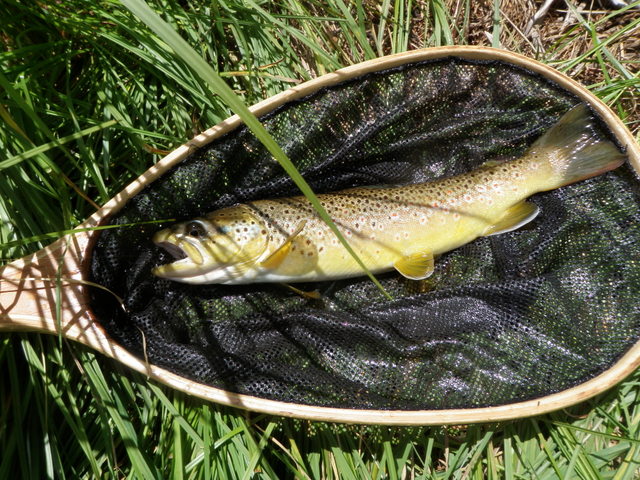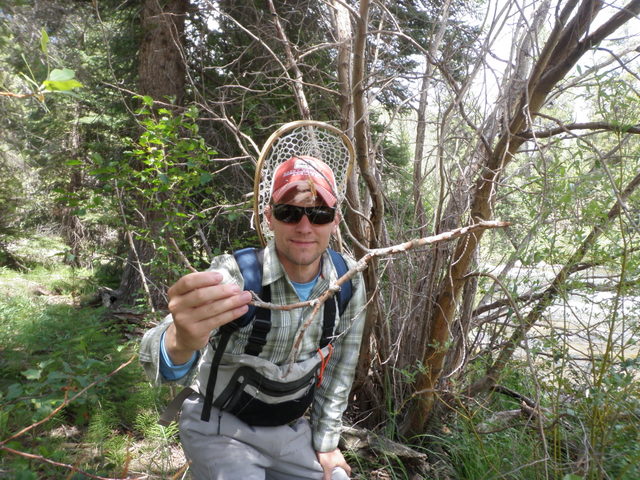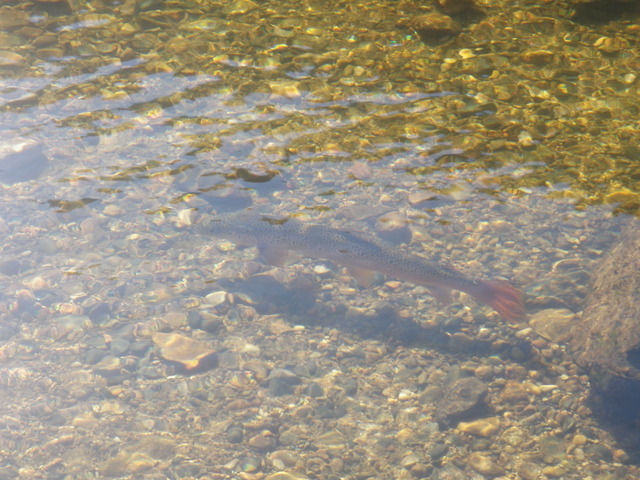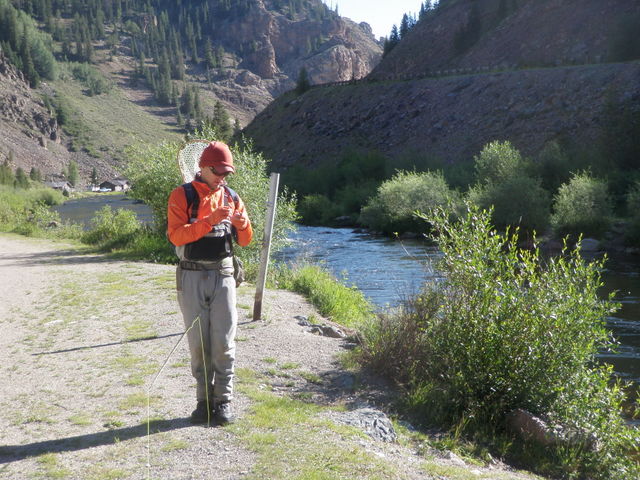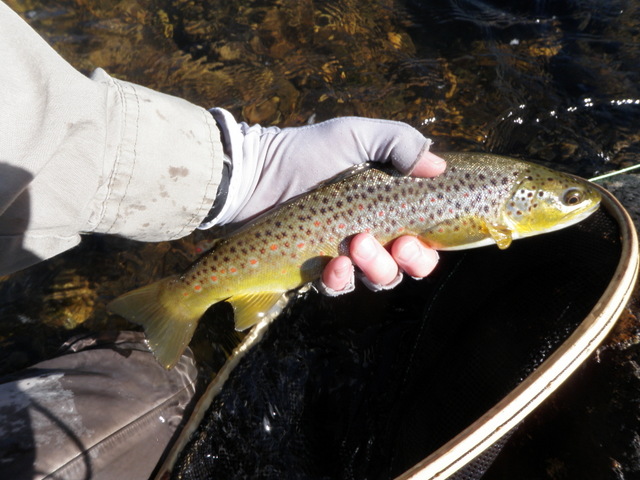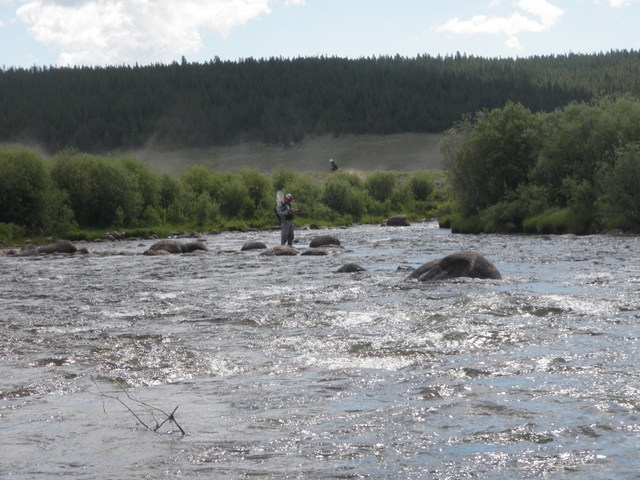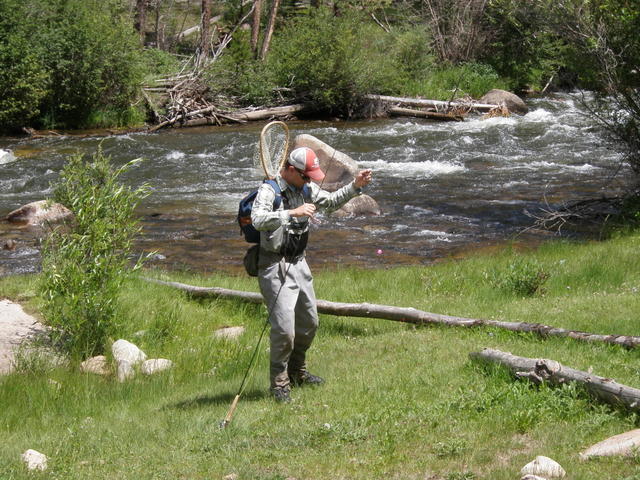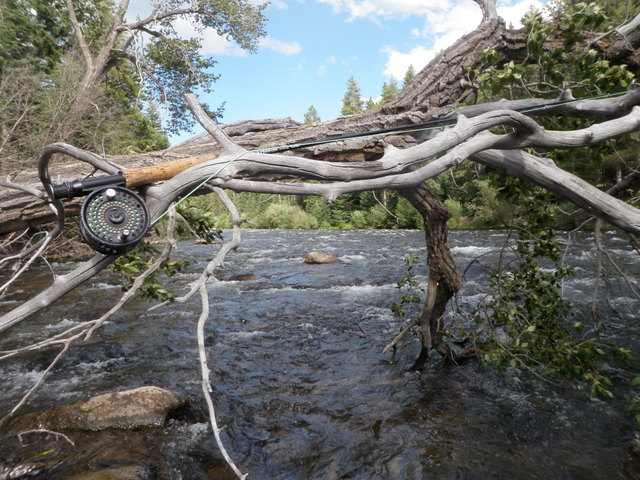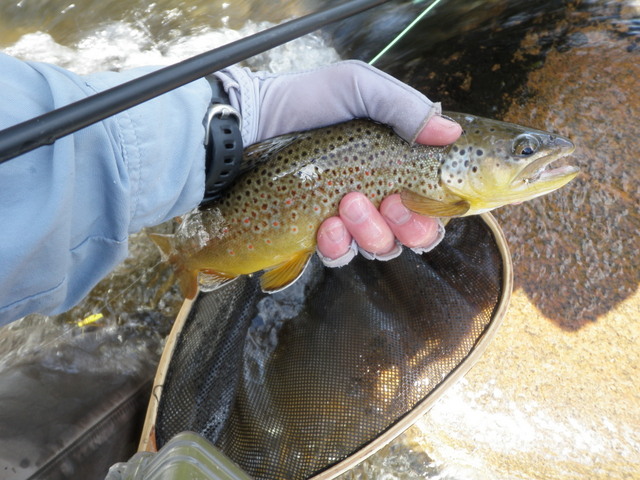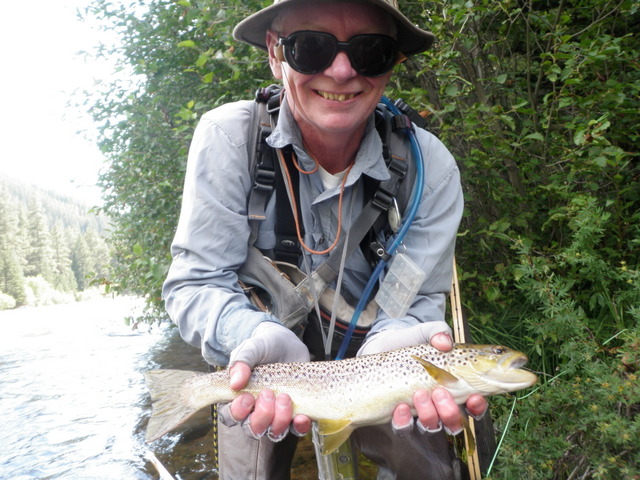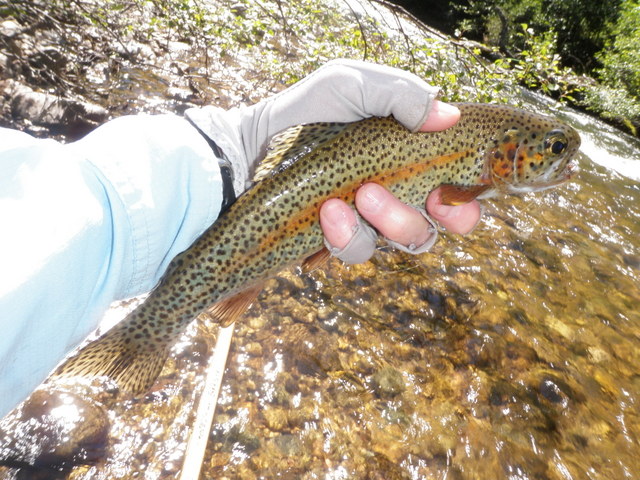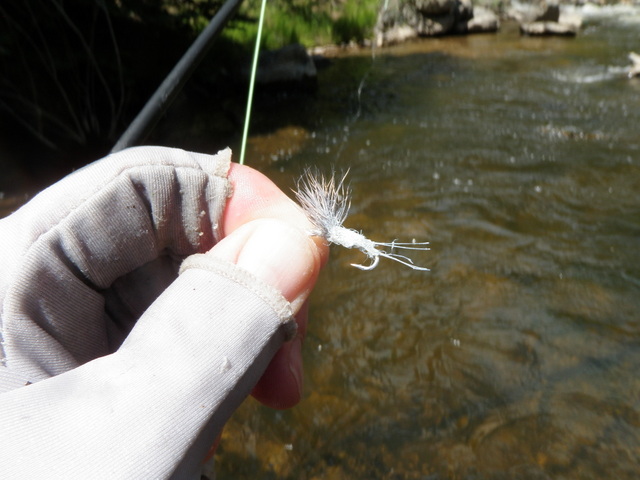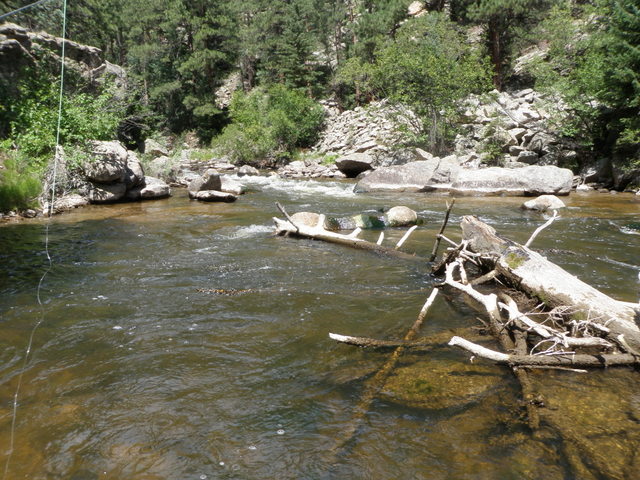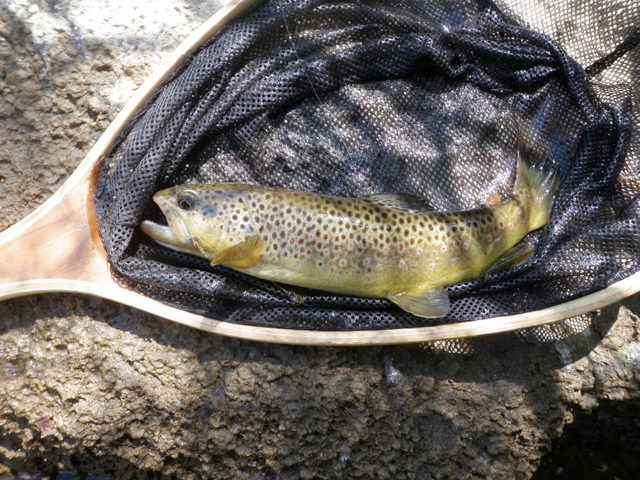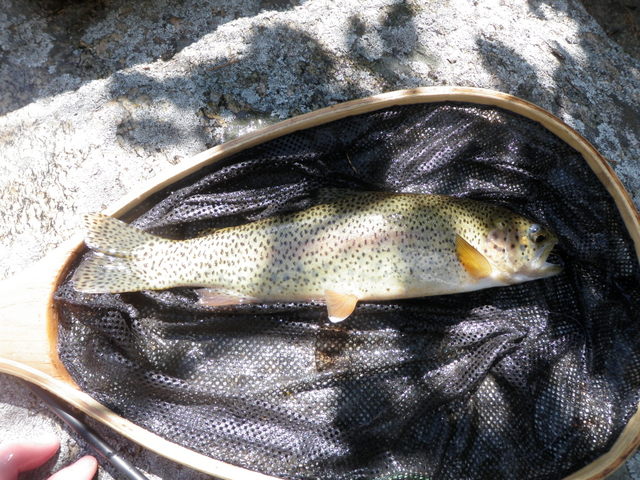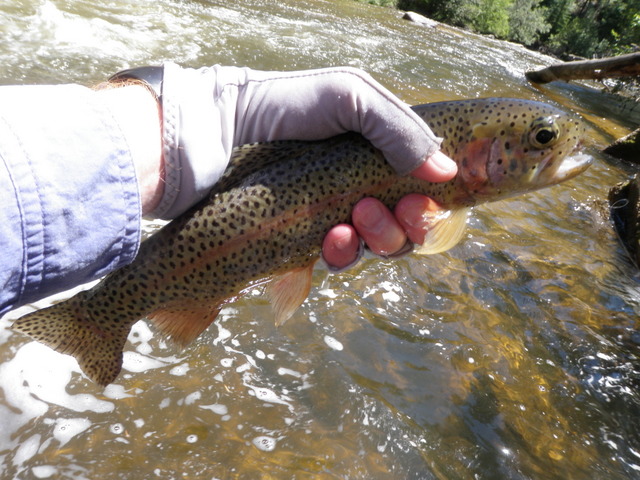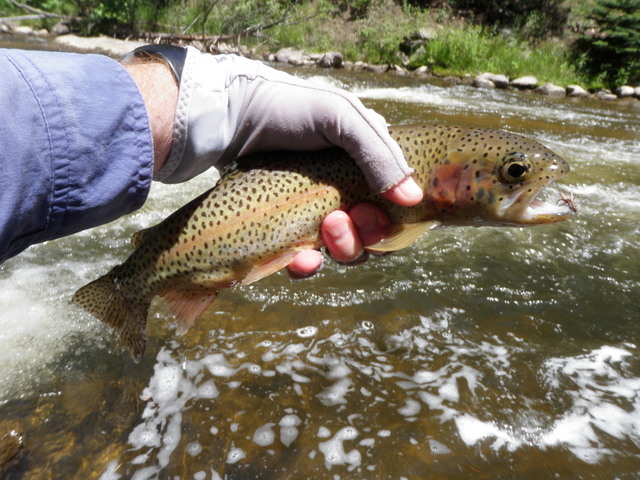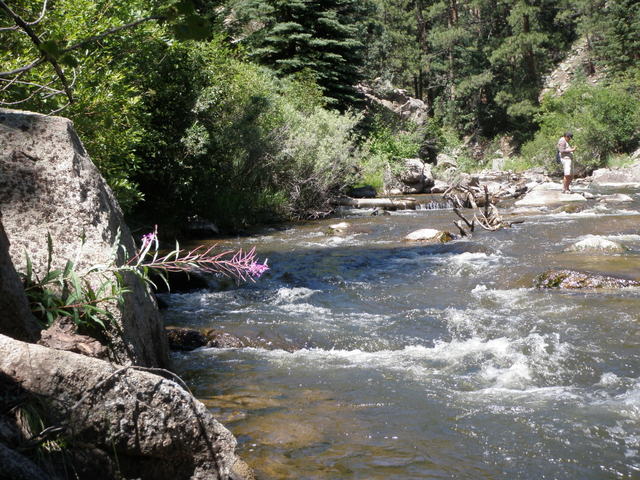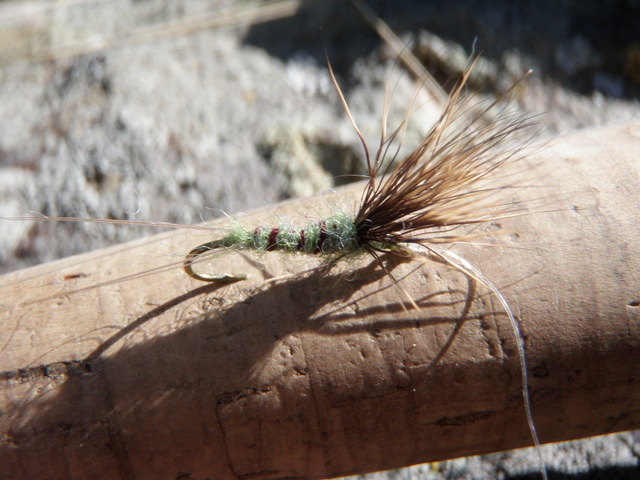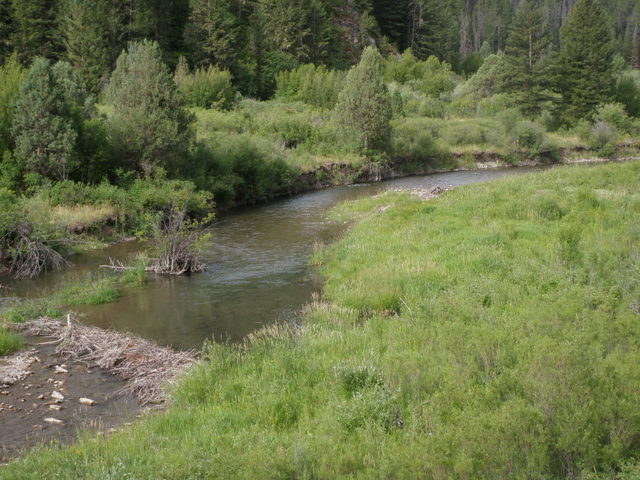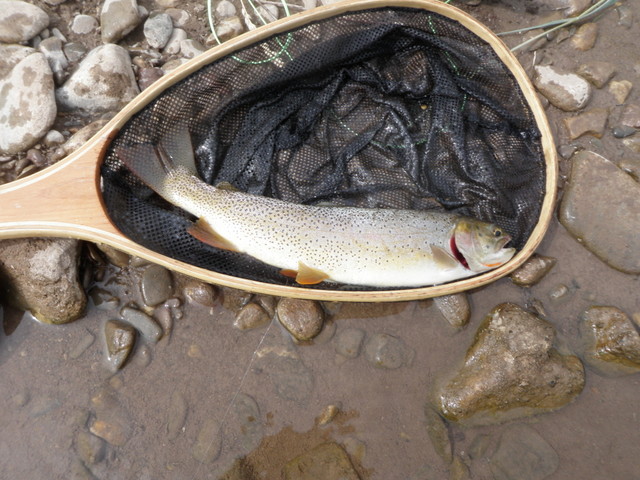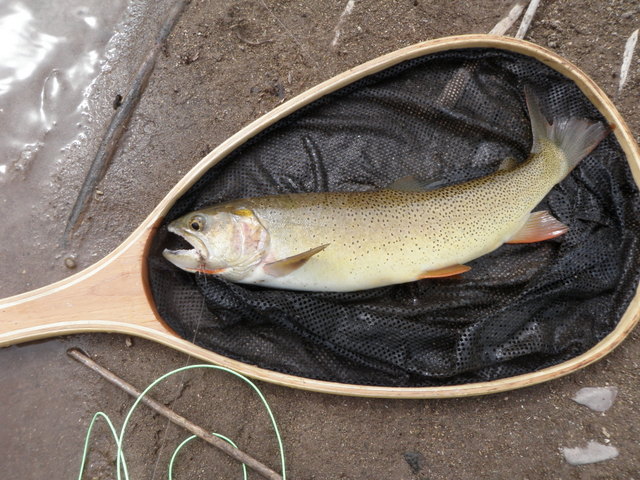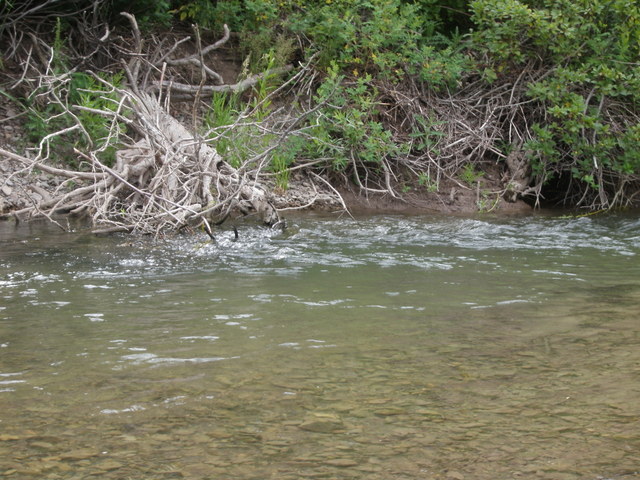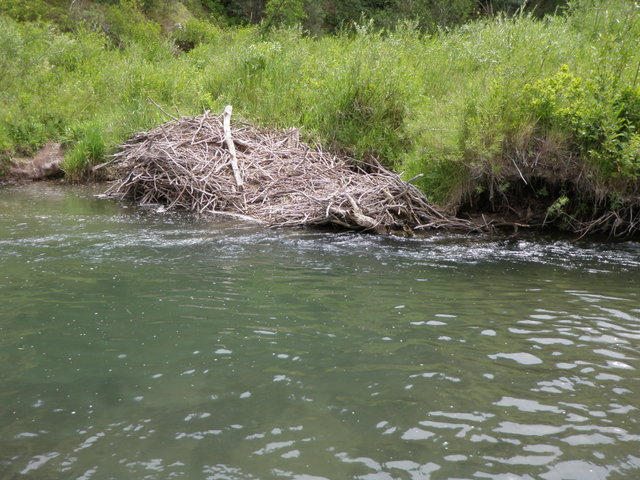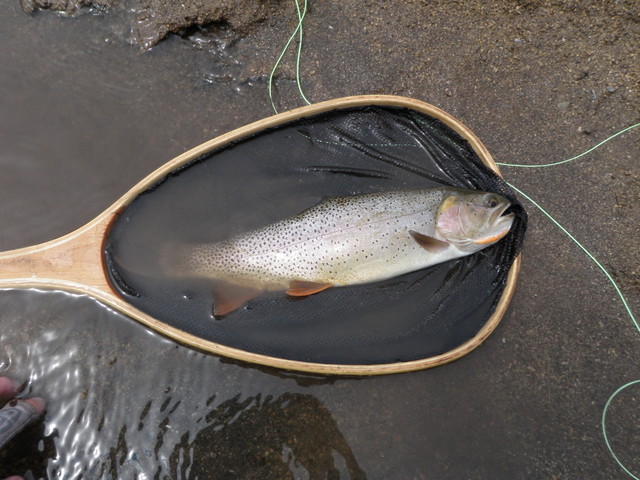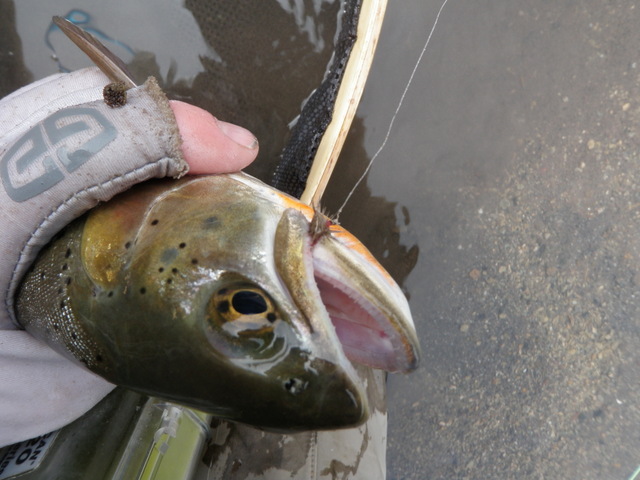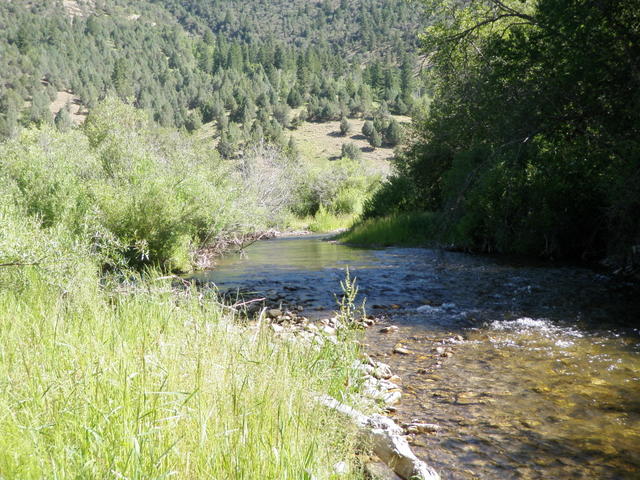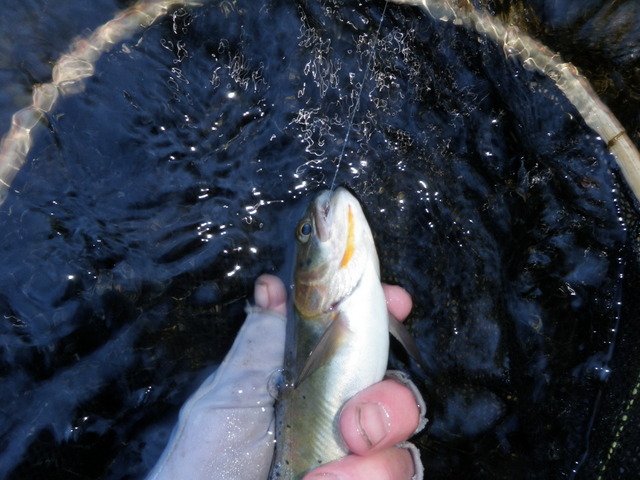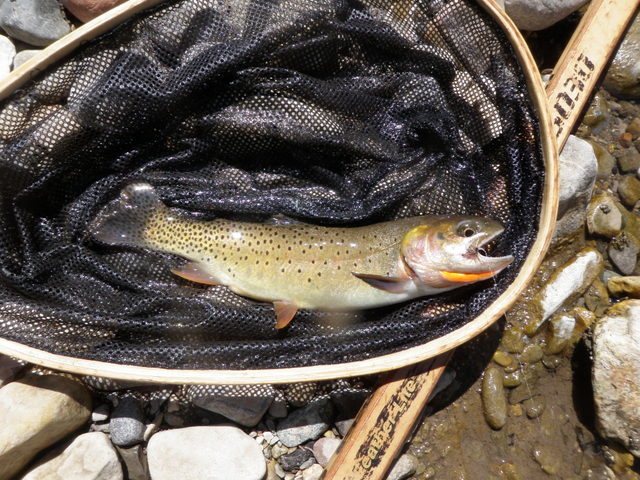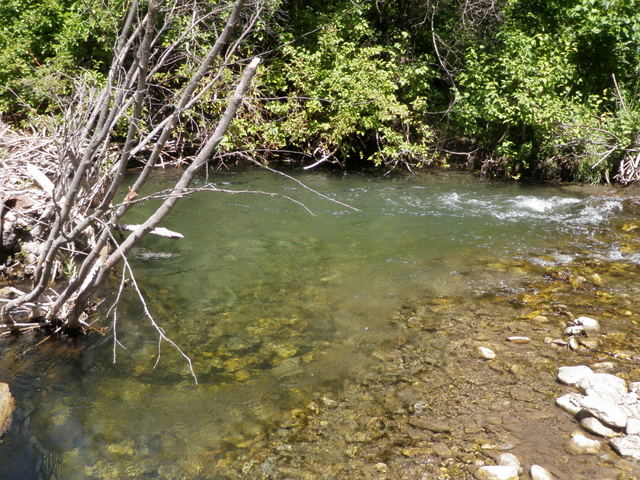Time: 7:00PM – 9:30PM
Location: A side channel on the south side of the river below the dam. The first water encountered after climbing a hill on Snake River Drive and then going around a large switchback.
Fish Landed: 1 (plus a whitefish not included in the count)
South Fork of the Snake River 07/26/2014 Photo Album
Could the fishing on the South Fork of the Snake River be as difficult as my experience on the Green River? I was really looking forward to fishing new water, but the flows were at 16,600 cfs, and that is a massive amount of water. My fear was that success required a guided float trip, and I did not have a partner to share the cost of such an undertaking. I was resigned to wade fishing, but where could I find access to some productive water at these high early season flows?
Jane and I had breakfast at our campsite and then packed up our tent and canopy and all our camping provisions. We were now headed to the Hansen Guest Ranch in Swan Valley, ID and the modern conveniences of running water and a bed. The volunteers at the Red Canyon Visitor Center in Flaming Gorge suggested that we try a different route from Flaming Gorge to Swan Valley, and we decided to follow their recommendation. We drove north to Rock Springs, west on interstate 80 to Green River, and then we took a secondary highway to route 189 just south of La Barge, WY. As we headed north on 189 we stopped at a nice Mexican restaurant in Big Piney and then continued north until we joined route 191. In the past we always took 191 from Rock Springs through Pinedale so the new route was a pleasant change.
We had no trouble finding the Hansen Guest Ranch, and owner and host, Tom, showed us our room. I asked about fishing, and he quickly directed me to the Rendezvous Fly Shop owned by Gary Duncan along route 26 in Irwin approximately four miles east of the ranch. After Jane and I got situated in our new surroundings, we made the short drive to the fly shop, and there we met Gary’s wife. I purchased a three day fishing license and began asking her questions about fishing the SF of the Snake River. She was doing a nice job of answering and provided directions to a spot that I could wade fish when Gary appeared. Apparently he had been in the back yard cutting the grass.
I asked Gary about a braided area I’d read about, but he felt that it would be difficult to reach this area with the flows at their current level. The article I read actually did suggest wade fishing the SF of the Snake in September when the flows are significantly reduced and conducive to wading. Gary pointed me toward the same area as his wife and suggested that I should fish there Saturday night as a scouting expedition. He then offered a key piece of information when he volunteered that a PMD hatch occurred at dusk, and I could expect a lot of fish to rise between 9 and 10PM.
In appreciation of this information I purchased three pale morning dun parachute flies and two pale morning dun nymph patterns, then we said goodbye and returned to the guest ranch. I wanted to explore Rainey Creek a bit, so Jane and I took another ride to the Rainey Creek Trailhead so I could scout this small tributary to the South Fork of the Snake River. Gary suggested that Rainey Creek might be productive as it did not have a national forest campground which brings many people and therefore more fishing pressure. He did offer Bear Creek as an alternative small stream to try and gave me directions on how to find it.
When we returned to the bed and breakfast, I decided to find the Snake River location that Gary described and adhere to his advice of fishing in the dark. I drove northwest on route 26, and in approximately four miles the highway crossed the river where I made an immediate left turn on Snake River Drive. I followed this dirt road for four or five miles until I climbed a short steep hill and then navigated a huge narrow switchback that took me away from the river and then right back to it. As I was going down the steep side of the loop, I encountered a herd of cattle, and it took pulling the Santa Fe amazingly close to the lead bull to force him to get out of my path.
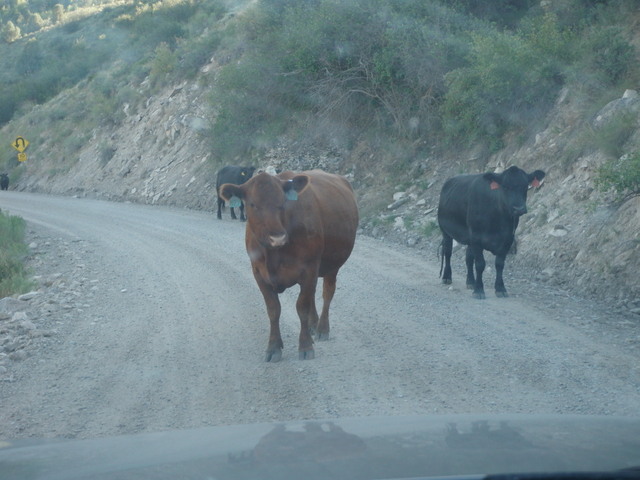
These Fellows Blocked My Path on the Way to Fish the Snake River
Where the road came back to the river, there was a nice side channel, and I decided to stop and fish at this spot. The size of the side channel roughly approximated the Frying Pan River in Colorado, so this was not the normal small side trough. A pickup truck was parked a few feet up the road, so before committing to the area, I jumped out of the car and surveyed the stream for another fisherman. I elected to use my Loomis five weight as I was weary of casting the Scott six weight, and the section I was about to fish looked perfectly sized for the smaller rod.
As I began to walk downstream toward the confluence with the main Snake, I bumped into the owner of the pick up truck. He was a nice young man, and he had been fishing since 2PM and had landed five fish. He stated that it was a bit slow, but he seemed relatively pleased with his success. He was using mainly a dry/dropper with a chubby chernobyl as his top fly and a small fly that looked like a PMD nymph imitation as his subsurface offering. The young fisherman reassured me that I would find several places to cross the side channel, and this was probably the best information he gave me, as I was quite fearful of wading in unknown water at high flows in fading daylight. While we were talking, a huge halo of mosquitoes circled his head, so as he walked away, I pulled out my small spray bottle of Off and doused my neck, face and hands.
I was now ready to familiarize myself with the mighty South Fork of the Snake River, so I continued along the bank to the point where the side channel merged with the main body of the river. I tied on a size 12 gray stimulator since that worked on the Green River, and I spotted a few large caddis flitting about in the air around me. I prospected back up the braid with the large attractor with no signs of fish, and when I reached a point just below the large bend pool, I decided to edge my way across the tail to the bottom of a small island. I tossed some casts into the attractive deep pool and then worked the other side of the island and fished the inside of the channel.
When I reached the point across from where the pick up truck had been parked, I crossed again and moved upstream a bit toward the point where the side channel branched away from the river. All of these moves yielded no fish nor did I see any signs of fish as the water was absolutely dead. I was convinced that Gary was having a nice laugh as soon as Jane and I stepped out the door of his shop. I retraced my steps and found a muddy path back to the road and returned to the large bend pool. I paused to observe for five minutes or so, and much to my surprise, I noticed a few sporadic rises in the middle of the pool by 8:45PM. In addition a light creamy colored mayfly fluttered up slowly from the surface. Perhaps Gary was telling the truth after all.
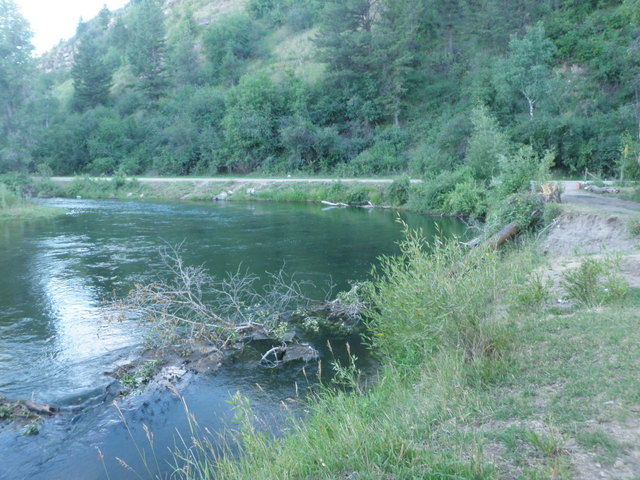
The Pool That I Fished on Saturday Night
These observations fueled my energy levels, and I positioned myself on the high bank next to the pool just above a large deadfall and began to loft a few casts to the location of the two rises. I could not get a good drift from this position because of my elevated position and the angle of the current, so I decided to cross again to the small island. Before I stepped in the water I was careful to make a mental note of my entry point as I would likely be returning in the dark. I slowly waded across the shallow current and then worked my way up to the small island on the northeast side of the attractive pool.
By now the frequency of the rises had increased so I added the purchased parachute pale morning dun as a second fly and kept the stimulator in place. I made some nice drifts over the locations of the rises with no results, so I began to worry that the fish were taking spinners, and I did not have a good spinner imitation on my leader. The time of day is what raised the spinner concern, but I reassured myself that I’d seen a dun floating up from the stream. I also seined the river briefly with my net, and this yielded a smaller blue wing olive dun.
Perhaps the parachute imitation was too large? I decided to snip off the stimulator and make the parachute my top fly and then add a size 16 gray comparadun as my point. It was clear to me that the fish were not tuned into caddis, so it made more sense to offer two PMD imitations. Finally by 9PM the hatch was in full swing and four or five fish began to smack the surface. I cast my two flies upstream to some still water four feet to the left of the current, and I was gratified to see a fish rise and sip in my parachute. Unfortunately when I quickly brought it to my net, I discovered a 12 inch whitefish. I was anxiously anticipating a Snake River cutthroat, so i was disappointed to encounter a whitefish as my first catch.
But fish continued to rise so I resumed casting in the rapidly fading daylight. As I drifted my flies through the center of the pool, a splashy rise along the current seam near the head of the pool caught my eye. I pivoted and shot a long 35 foot cast to the vicinity of the rise and saw a quick swirl and set the hook. This fish immediately rocketed toward the sticks and logs in the deadfall across from me, but I managed to pressure the projectile away without breaking it off. Clearly this fish was behaving like a trout and not a whitefish.
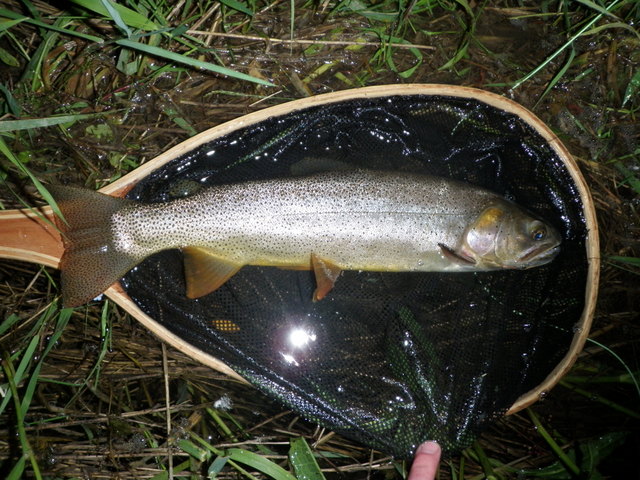
The Snake River Pool Yielded This Handsome Cutthroat Saturday Night
When I moved the fish closer to my net, it made one more short burst that took line, but I regained control again and netted a gorgeous 16 inch Snake River cutthroat. What a thrill! By the time I released my prize catch it was 9:30 and getting quite dark, and the frequency of rising fish had slowed considerably so I called it quits and returned to the guest ranch. Saturday night was a solid introduction to fishing the South Fork of the Snake River.
Like this:
Like Loading...

